We may earn money or products from the companies mentioned in this post. As an Amazon Associate, I earn from qualifying purchases.
Nestled amid the rocky escarpments and dusty sage grass of the central Texas plain lies the Robert E. Howard Museum. It’s in a sleepy city called Cross Plains, a rural outpost steeped in Americana and small-town simplicity. In this unremarkable place, Robert E. Howard created some of fantasy fiction’s greatest, most beloved characters. He lived from 1906-1936 and spent the last 17 years in Cross Plains.
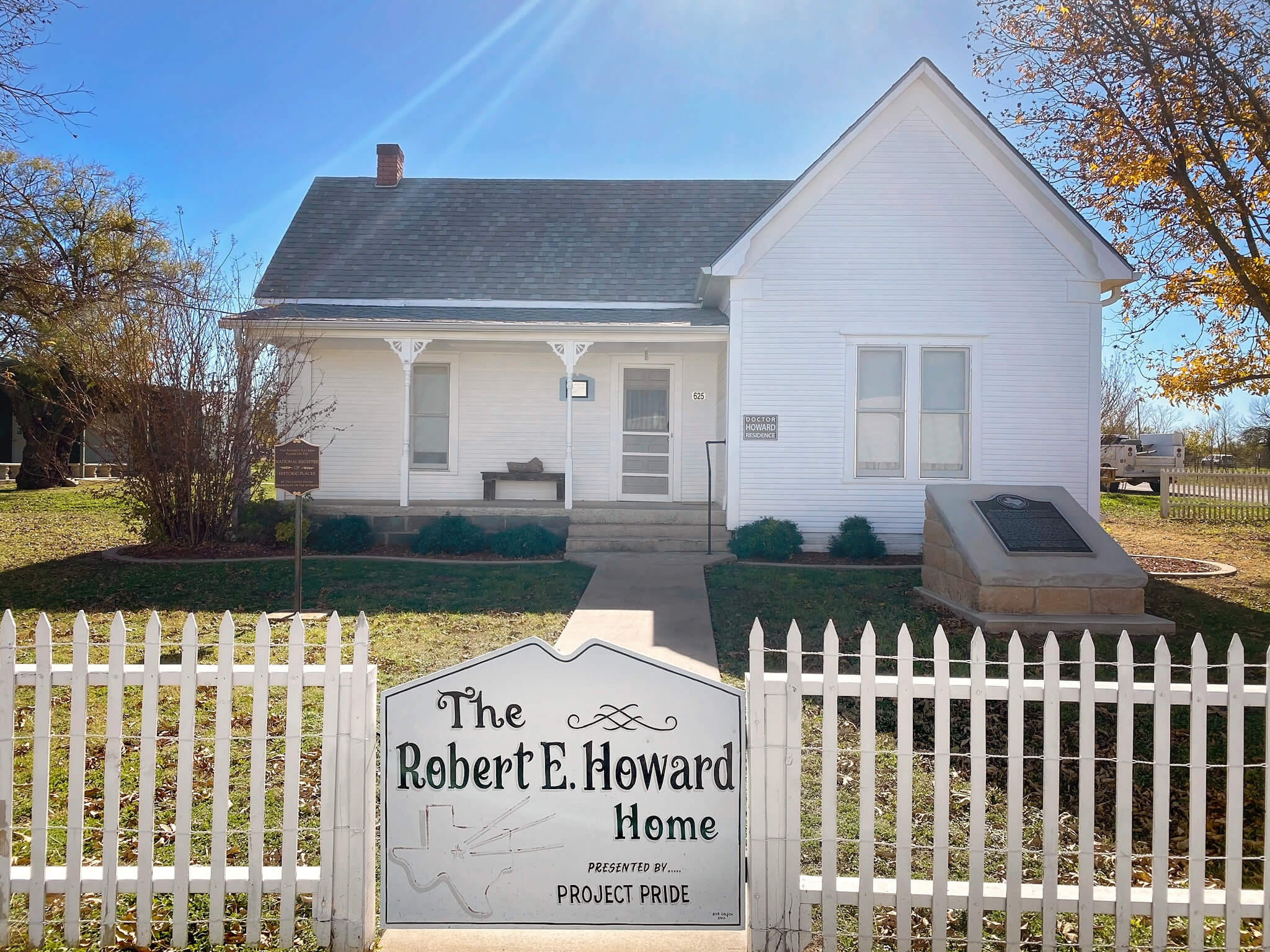
From his small bedroom, and largely in literary isolation, Howard carved a path no writer had ever traveled. The vast haunted halls of Howard’s mind conjured mighty kings, horrific demons, ancient empires, and entirely new worlds through which his spirit traveled, teleporting him out of the mundane affairs of small-town Texas life and into magical new realms populated by some of the most celebrated characters of American pulp fiction: Conan the Cimmerian, Solomon Kane, Red Sonja, King Kull, Bran Mak Morn, and many more.
Finding the Robert E. Howard Museum
My visit to the Robert E. Howard Museum culminated a lifetime of on-again, off-again encounters with Howard’s works. As a kid, I read his Conan stories. I fell in love with his gritty, dark, immersive worlds inhabited by indomitable heroes and fierce monsters.
His books were always accompanied by terrifically good illustrations that beckoned the reader into a lurid place of adventure and mystery. When I saw the Conan the Barbarian and Conan the Destroyer movies, I fell in love again.
Through these encounters, I was reminded of Howard’s power in shaping the topography of fantasy fiction across generations and continents. As I grew older, I would pull his reprinted works off the shelves at bookstores, thumb through them slowly with a smile, and dream of high adventure.
At some point, I learned there was a museum somewhere in Texas where you could visit his childhood home. To me, that Museum was as mysterious as Howard’s worlds, a tiny dot isolated in a vast unexplored hinterland, a place bridging real and imagined worlds. I knew that someday I had to find a way to get there.
Cross Plains, Texas
Cross Plains, Texas, is a place out of time, a quite rustic small town located in what not too long ago was the heart of Comanche Indian territory, the last outpost of “civilized” traders and homesteaders hailing from the east. Trees become sparse in this land of prairie and savannah, and the rocky sun-cracked earth stretches endlessly under a big sky.
Cross Plains is located 158 miles west of Dallas and 217 miles north of San Antonio. For the last 50 years, this small town has maintained a population of around 1,000.
History of Cross Plains, Texas
The history of Cross Plains is the story of a remote prairie town pulled from obscurity initially by a new railroad connection, then by an oil boom, and again by a museum. Cross Plains is five miles east of the East and West Caddo Peaks. This was a landmark used by Native Americans and military units to navigate the mostly flat plains. It also lies near Turkey Creek, a reliable water source in arid lands.
Before the Civil War, the area was used as a campsite due to its location at the crossroads of existing stagecoach and military roads.
In 1911, Cross Plains was relocated from the west bank of Turkey Creek to its present location, and in 1912, the Texas Central Railroad came into town. This ushered in an era of rapid population growth, business speculation, and connectivity with the quickly growing urban centers in eastern and southern Texas. Cross Plains, at this time, wasn’t much more than a main street with a general store, a cotton gin, and a grist mill.
In 1925, oil was discovered near Cross Plains. This quickly turned the mostly quiet town into a bustling destination flooded with roughnecks, speculators, gamblers, brawlers, and an entourage of ancillary opportunists that traveled from boom town to boom town. This was the Cross Plains of Robert E. Howard’s time. Much of what we know of this era of Cross Plains comes from the local newspaper.
The Cross Plains Review started in 1909 and continues to be published today.
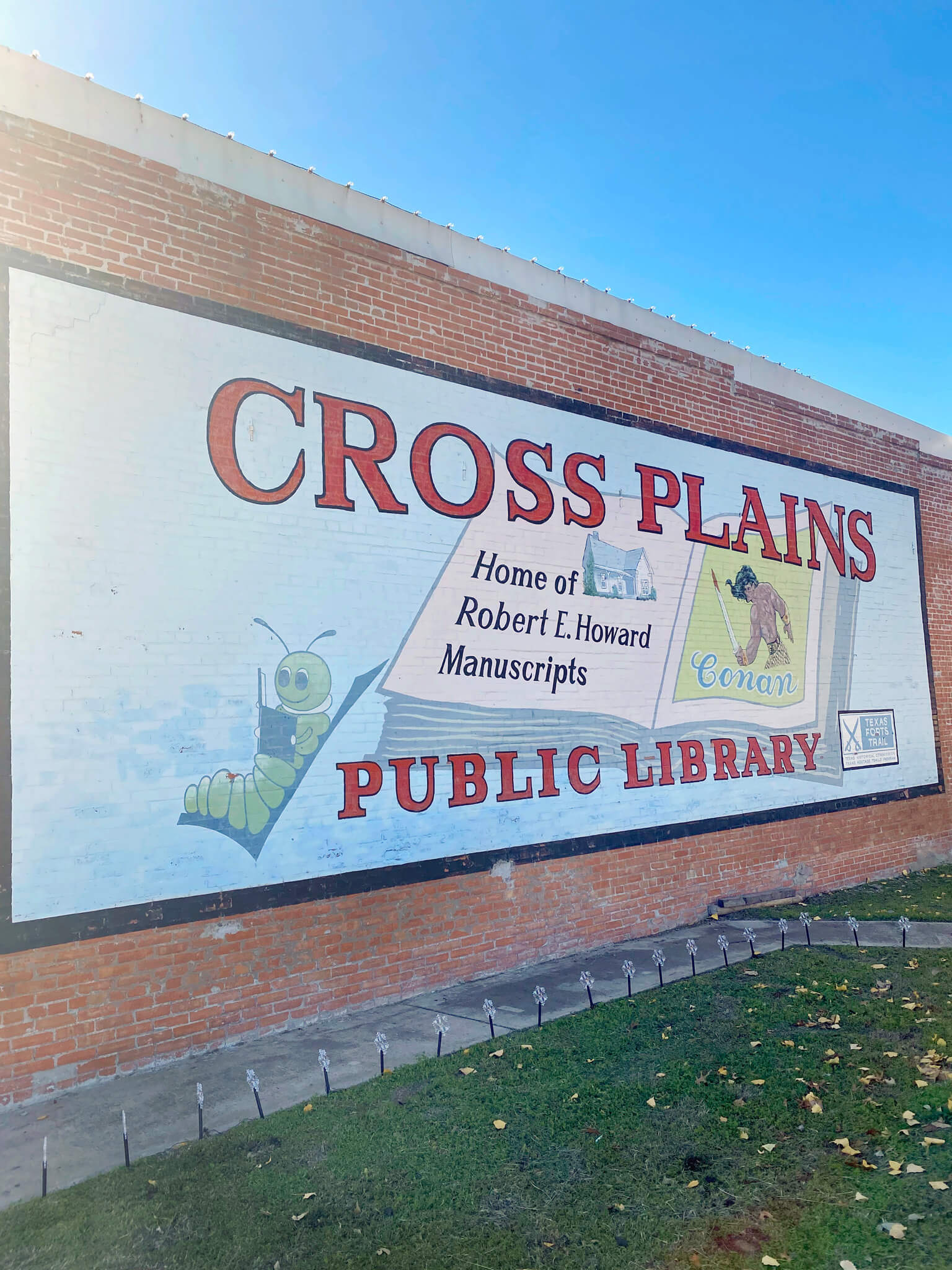
Cross Plains Texas Today
I drove into Cross Plains from the northeast, along Hwy 206. I passed scattered homes nestled amidst scrub brush and long stretches of winding two-lane highway. The highway effortlessly transformed into Main Street, a quaint series of brick businesses, boutiques, and restaurants lining either side of the street. I had no idea where anything was, so I pulled into a parking spot along Main Street.
A nearby woman quickly approached me and asked if I needed help. I told her with a smile I was “on a pilgrimage looking for the Robert E. Howard Museum.” Her face lit up. She showed me her family’s storefront, which had been operating for the last 60 years, and offered lunch recommendations. Her pride for Cross Plains was palpable, and she effused the type of small-town hospitality you can only find in rural places, places where neighbors still talk to neighbors.
The city has one stoplight, a gas station, and a high school. There’s also a Subway, a Dairy Queen, and three locally owned restaurants: Backwoods Texas Style Grill, Mexico City Cafe, and Bubba’s BBQ. I had lunch at Mexico City Cafe, which was excellent.
Cross Plains, Texas is a wonderful small town with a rich history of surviving, thriving, and remaining mostly unchanged over decades.
The city embraces the huge specter of Robert E. Howard as if it were the proud caretaker of something magical, like an excited child leading a friend to an undiscovered place. It opens its wide arms with a smile and welcomes pilgrims from around the world who come in search of Howard, and often in search of themselves, amidst the sun-beaten cross-timbers and wild prairie grasses of central Texas.
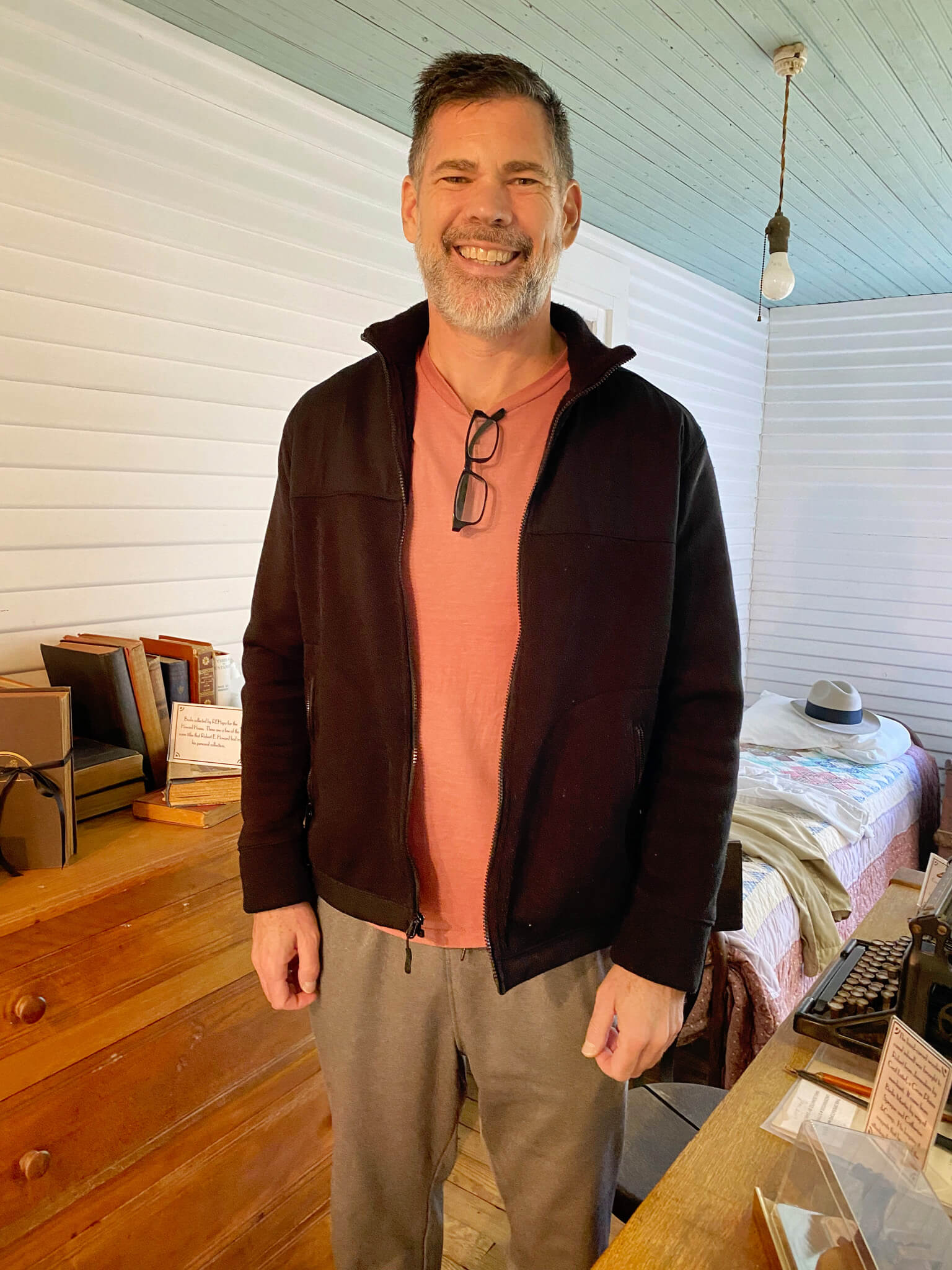
The Robert E. Howard Museum in Cross Plains, Texas
Robert lived in Cross Plains from 1919 until 1936 with his mother, Hester Jane Ervin Howard, and his father, Dr. Isaac Mordecai Howard. The family home has been fully restored to its original condition. It is now a repository of Robert E. Howard’s furniture, books, manuscripts, pictures, and other belongings.
Making An Appointment to Visit the Robert E. Howard Museum
The Robert E. Howard Museum doesn’t have full-time staff who operate the Museum during traditional business hours. You must make an appointment with one of its two part-time caretakers to enter the house. Their contact numbers are on this Museum website.
I called one of the caretakers, Arlene Stephenson, about a week ahead and arranged for her to meet me at the home the following Monday.
Arlene is absolutely amazing! She is the current President of Project Pride and has been involved in the Museum from the early stages. She knows all the major players who occupy the “inner circle” of Howard scholars, biographers, and superfans. Arlene is one of the bedrocks of the Museum, an intelligent, knowledgeable, caring, and professional advocate for the Museum and Cross Plains.
In many ways, she is the human face of the Museum, a loving caretaker who sacrifices her own time to introduce strangers to Howard’s home, life, and legacy.
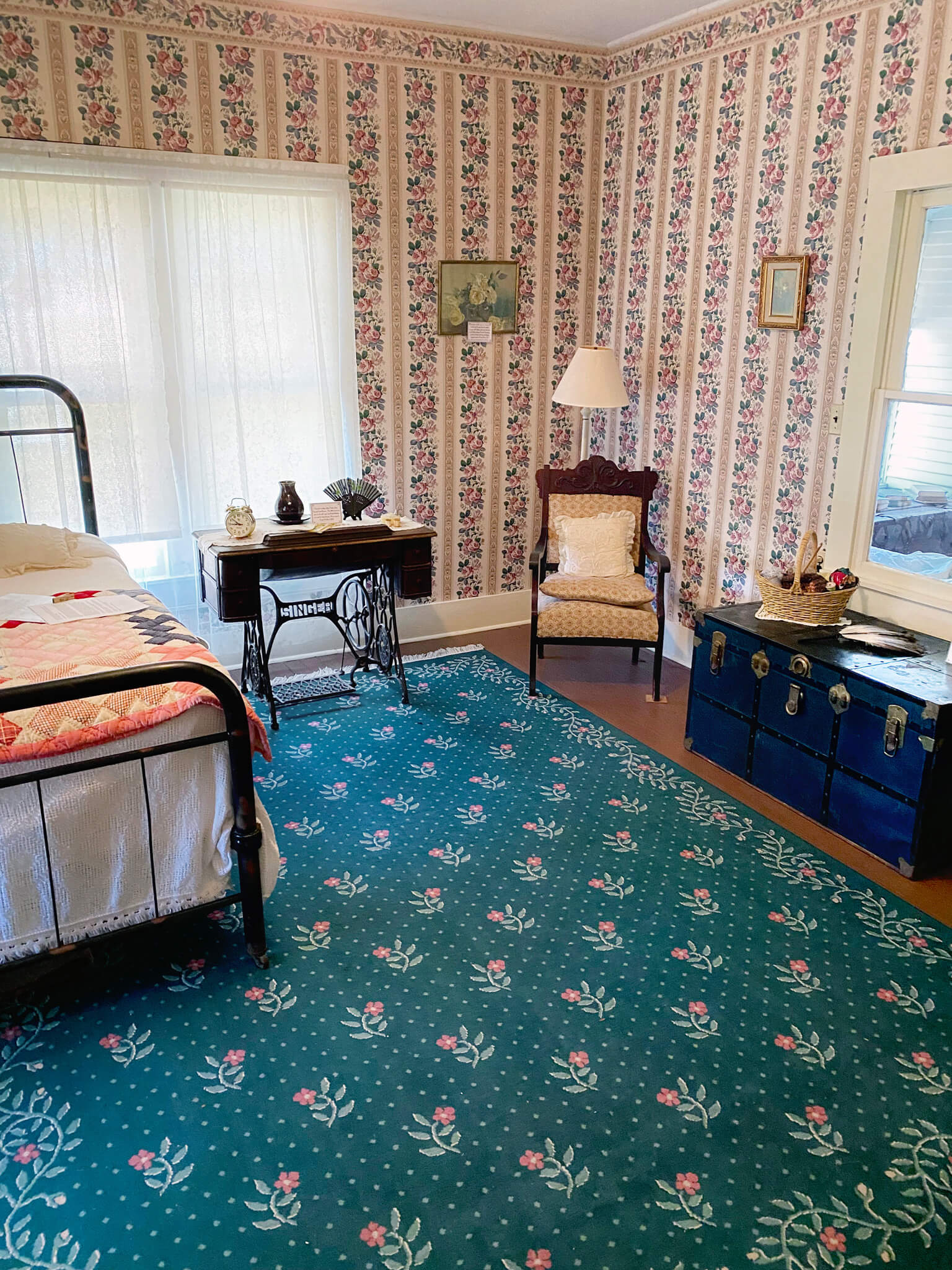
The Robert E. Howard Museum
The Robert E. Howard Museum lies just west of the only major intersection in Cross Plains. It’s a nondescript single-story wood-sided 20th-century farmhouse. It’s shutterless with a front-gabled sloping roof. The only architectural ornamentation is thin wood porch columns bearing ornately carved capitals. I later found out that a carpenter had hand-made these to match pictures of the front facade from the 1930s.
A painted short white picket fence encircles part of the property, and a prominent but simple wood sign hangs from the front gate, reading “The Robert E. Howard Home: Presented By Project Pride.” An angular concrete slab monument in the front yard bears a Texas Historic Landmark marker.
The home sits on a corner lot facing the road. There’s a grassy area behind the house for parking. The neighboring parcel of land on the east was purchased and added to the property later. A covered pavilion was built here to accommodate special events and gatherings.
A gnarled tree with three meandering trunks rises on the eastern side of the house next to the pavilion. At its base is a metal plaque inscribed “In Memory Of Patch, Howard’s Faithful Friend.” Patch was Howard’s beloved dog, whom he raised from a puppy. Patch died sometime around 1928-1929 when Howard was in his early twenties.
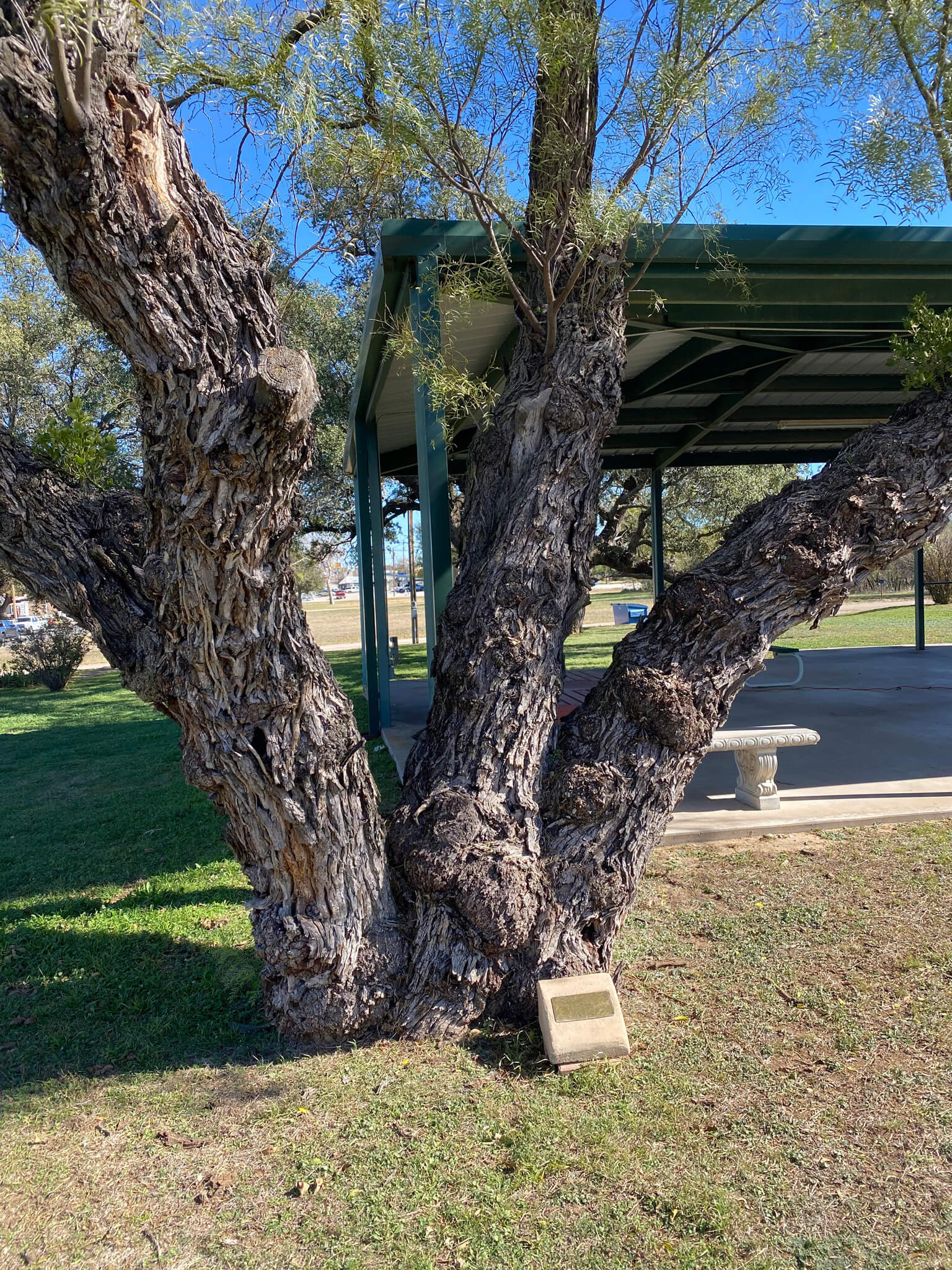
The house was placed on the National Register of Historic Places in 1994. It received a Texas Historical Marker in 2019.
The Howard house is understated and fittingly representative of how it would have appeared when his family lived there. There’s nothing flashy about it. It doesn’t feel like a tourist attraction, and I think Howard would have liked it that way. It’s unrefined, stoic, unabashedly Texan and stands quietly unyielding in the currents of unrelenting time.
Robert E. Howard Museum Collection
The house’s interior is period-authentic and immediately makes you feel like you’ve stepped into the 1930’s. Great care has been taken to restore the home with original paint colors, wallpaper patterns, furniture, appliances (like the stove and radio), and family pictures.
The house is filled with fascinating things like his father’s bible, a bust of Cleopatra Howard purchased, books he owned, original manuscripts, data about his writing income, correspondence with HP Lovecraft, bibliographies, maps of Cimmeria, movie posters, pictures of Howard’s family and friends, pictures of Cross Plains, various reprintings of his stories, poetry compilations, and personal documents like his canceled checks.
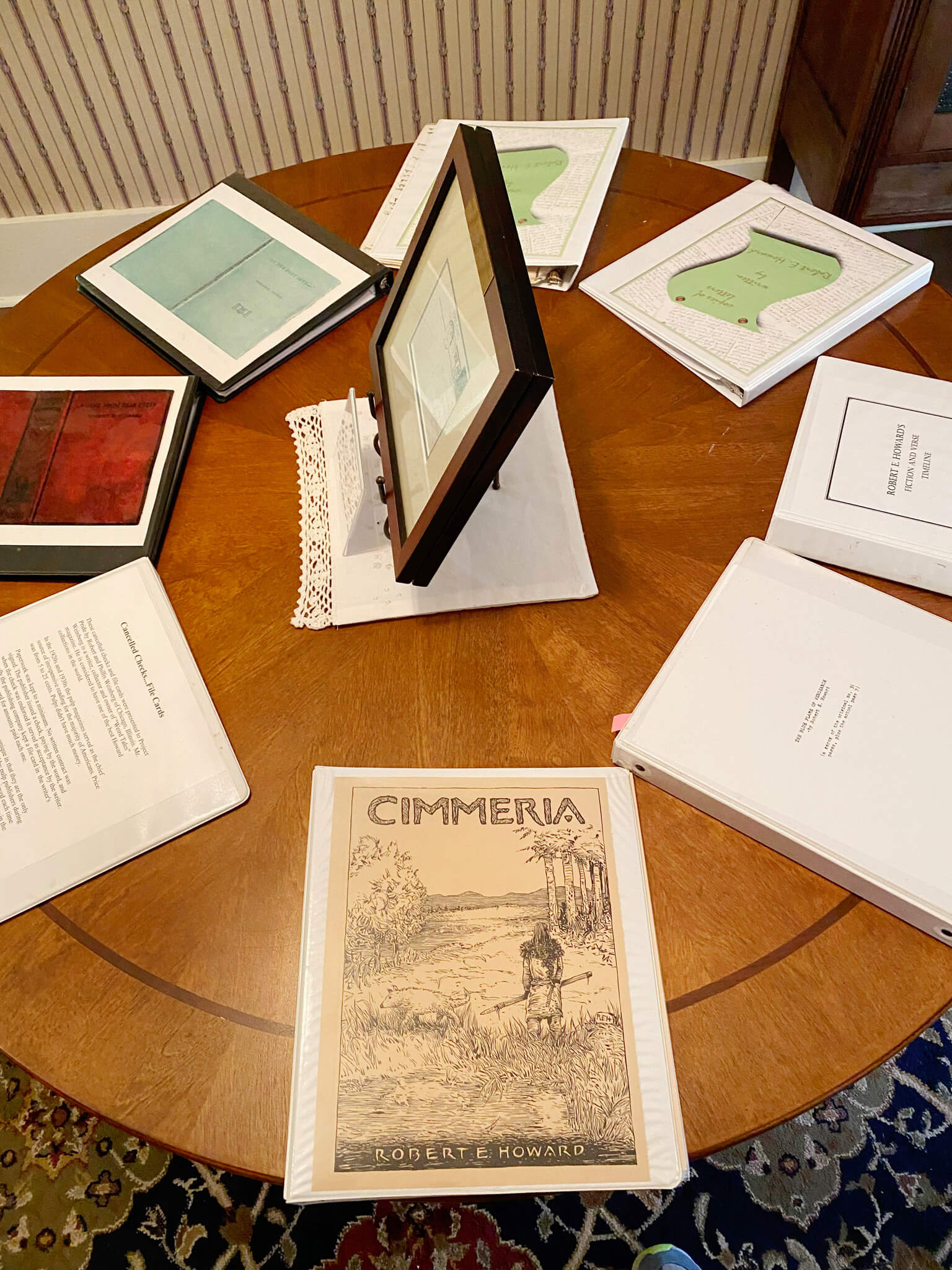
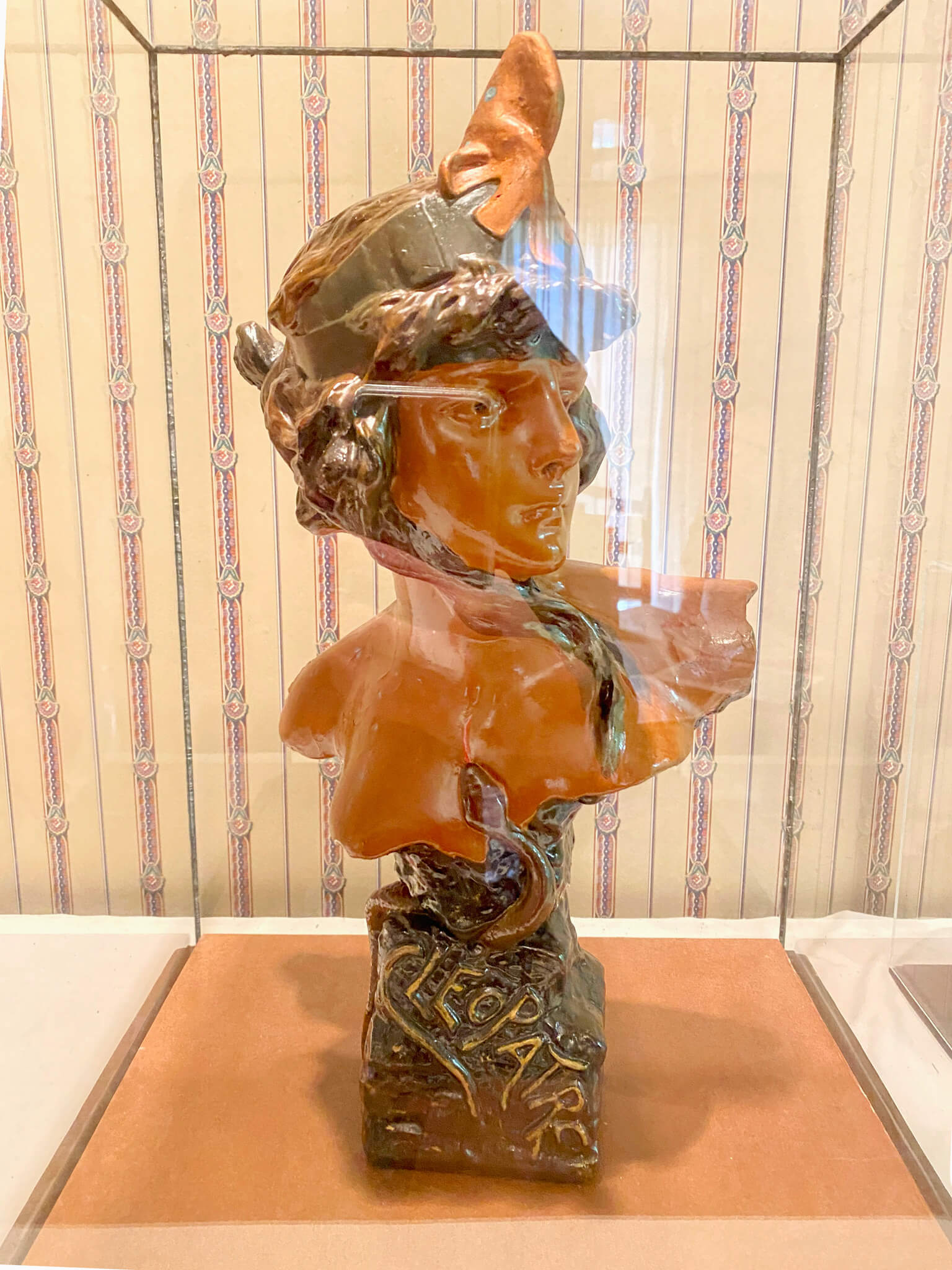
When possible, organizations like the Robert E. Howard Foundation have secured the original belongings of the house from private collectors.
Over the years, some original pieces were willed or donated to the Museum by individuals who benevolently saw the value of returning Howard’s belongings to their rightful home. Fans worldwide have united to ensure Howard’s personal effects returned to Cross Plains.
Arlene spent almost three hours with me and gave me an incredible personal tour of the entire house. She knew the detailed history behind each piece and provided fascinating color commentary about special guests who had visited the Museum in the past.
With every story, I better understood the intense personal meaning Howard’s writing had for so many. His words, echoing across time and from someplace wild, had inspired people from every country, gender, socio-economic status, physical ability level, and age. She told me about a young man who came with his father to the Museum a while back. He was blind and had read Howard’s stories in braille as a kid. He asked Arlene to let him run his fingers over the different pieces so he could “see” them.
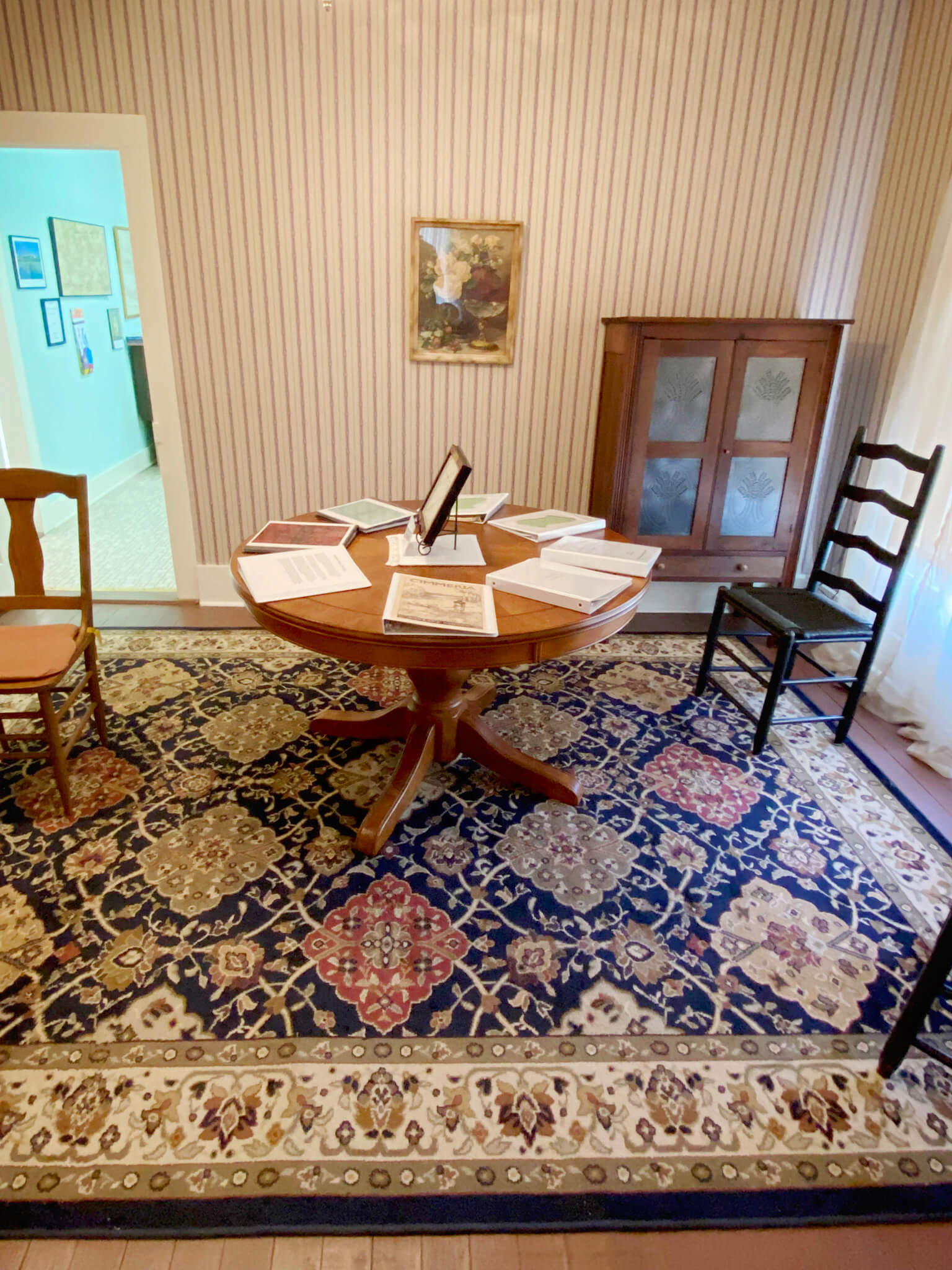
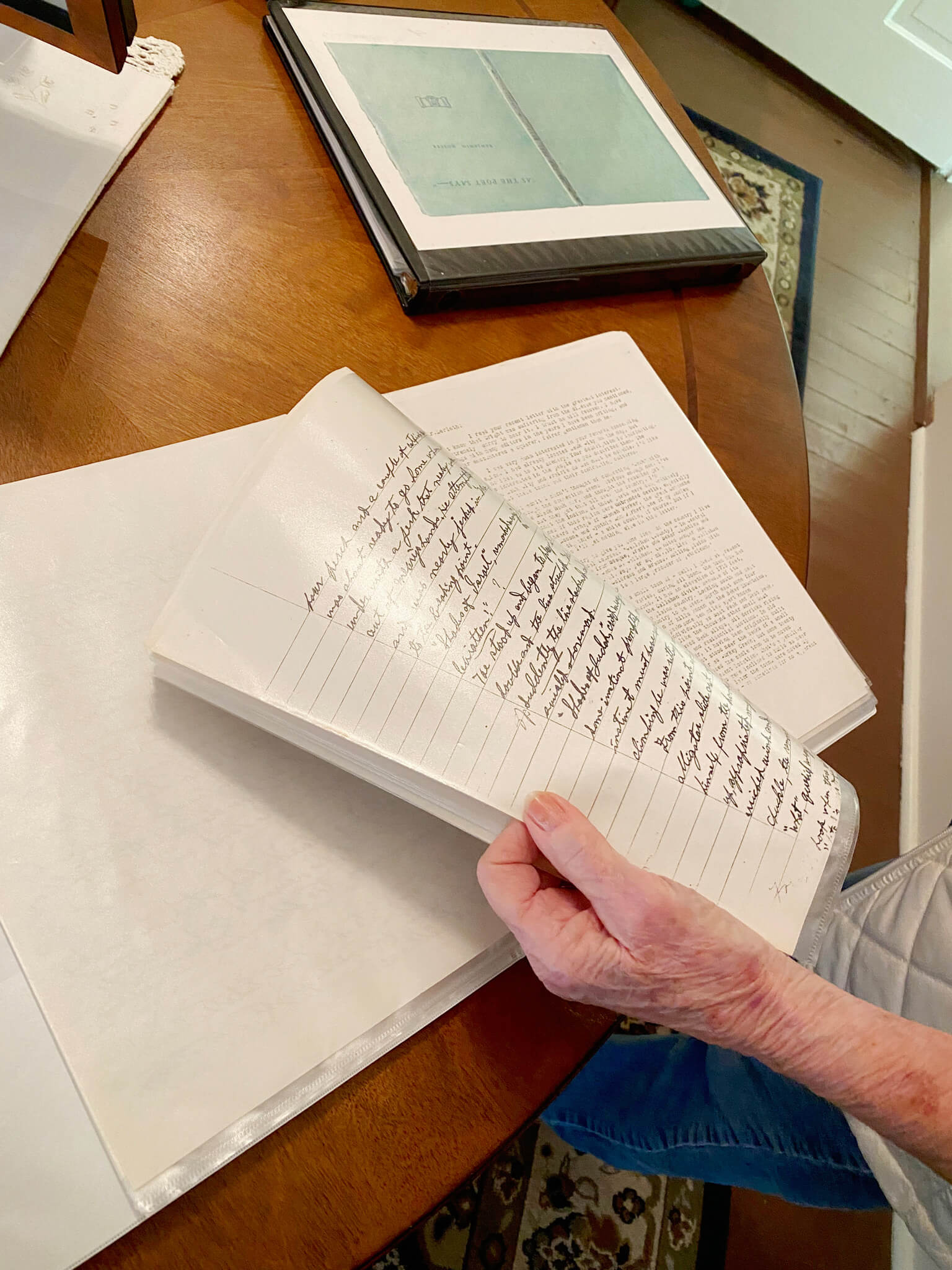
Robert E. Howard’s Room
Within the home, Howard’s bedroom is a special place. It’s where he spent much of his time reading, thinking, and writing his stories. It’s a small, narrow room, maybe 8′ by 14′. It used to be the home’s back porch but was walled in and converted into Howard’s bedroom as he got older.
It’s meticulously preserved to appear as it did when Howard lived and wrote in it. Here you can see his typewriter (same make and model but not original), writing desk (which will soon be replaced with the original), bed, chest, and bookshelf. A fedora in his style waits on the bed.
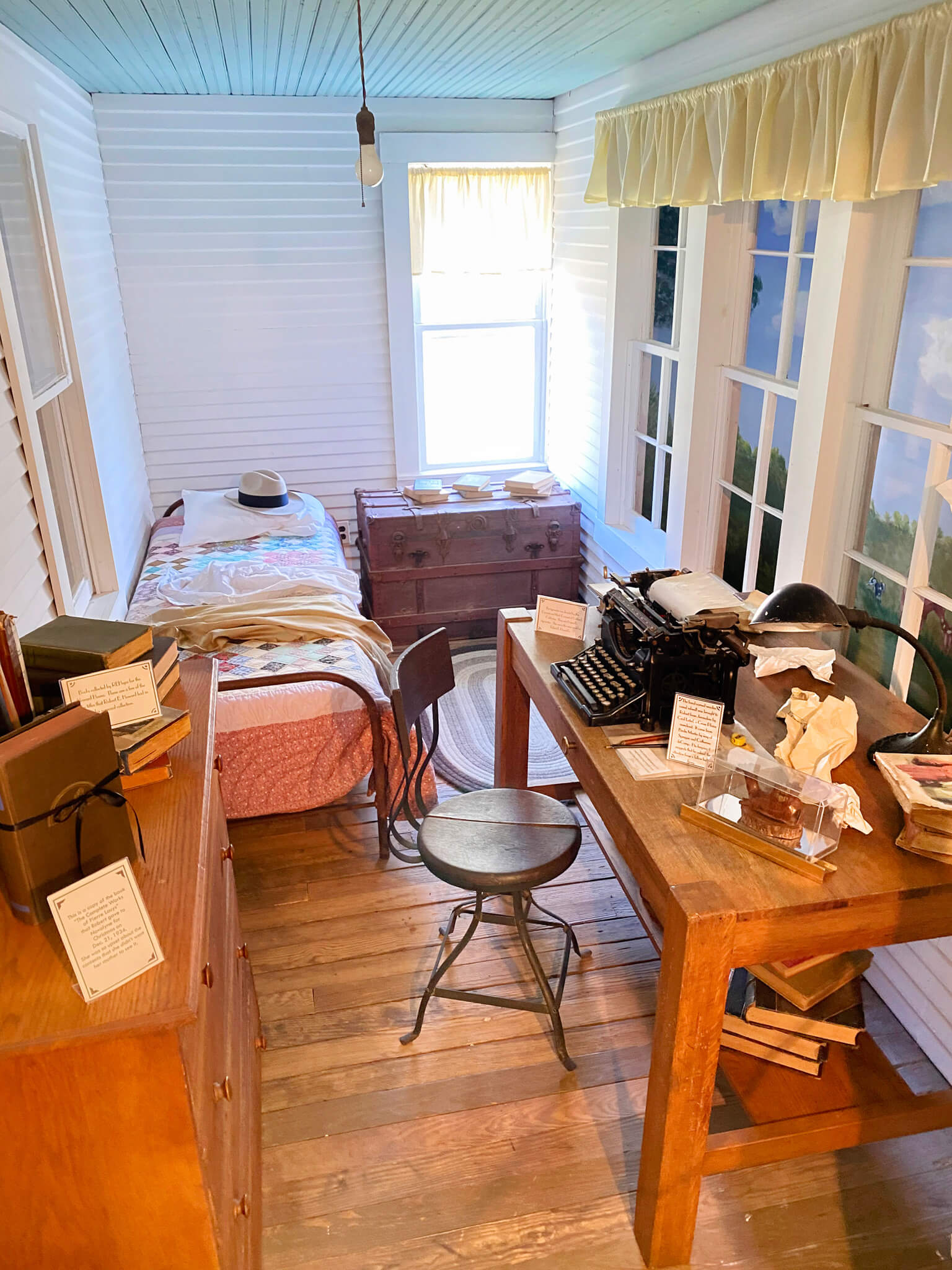
It’s impossible not to contrast this small space with the huge worlds and characters Howard inhabited in his mind.
From this unimpressive room, mighty empires rose, the dark depths of the seas yielded unimaginable mystery, and strong heroes trod the jeweled highways of the world beneath sandaled feet. Howard lived his life atomized in Cross Plains but free and unchained in the mansions of his mind.
The Gift Shop
The Robert E. Howard Museum gift shop is a small room near the back of the house. Arlene led me to it at the conclusion of our time together. As you can imagine, it’s filled with different Howard related items.
These include hard and softcover books, biographies, T-shirts, posters, postcards, and other souvenirs. Much of it bears excellent fantasy artwork created by fans. It’s all cool. I bought a white T-shirt with a drawing of Howard and several of his characters and a copy of the biography “Blood and Thunder.” I took a tri-fold Museum informational pamphlet and a few bookmarks for my kids.
Only cash is accepted for purchases.
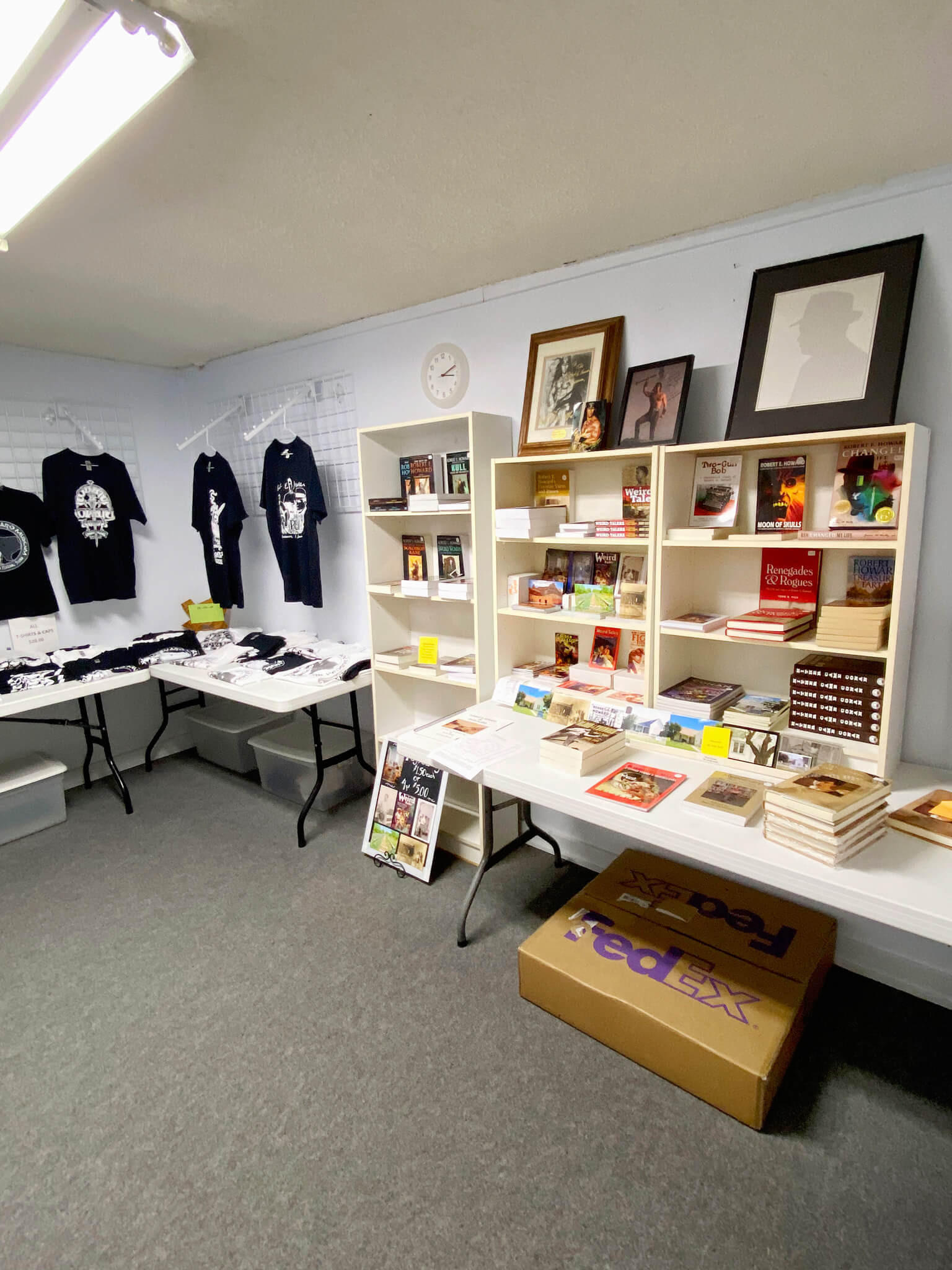
The Efforts of Project Pride
The Robert E. Howard Museum would never have existed without the concerted efforts and generosity of a local group called Project Pride. Project Pride was formed in 1988 by concerned citizens of Cross Plains as a civic organization. Its original intent was to improve the city’s image and aesthetic presentation by getting property owners and businesses to clean up their lots.
Project Pride wanted Cross Plains to avoid the slow atrophy and economic decline suffered by many rural towns across America. The organization solicited funds and purchased Robert E. Howard’s home in 1989. It was in great disrepair at the time, so they began renovations leading to what is seen today.
Project Pride owns the Robert E. Howard Home and land and is responsible for its upkeep. It relies on a small but incredibly dedicated group to staff the Museum, maintain the property, and perform repairs. Its sole sources of income are charitable donations, museum gift shop sales, and the small revenue it generates from special events like Howard Days.
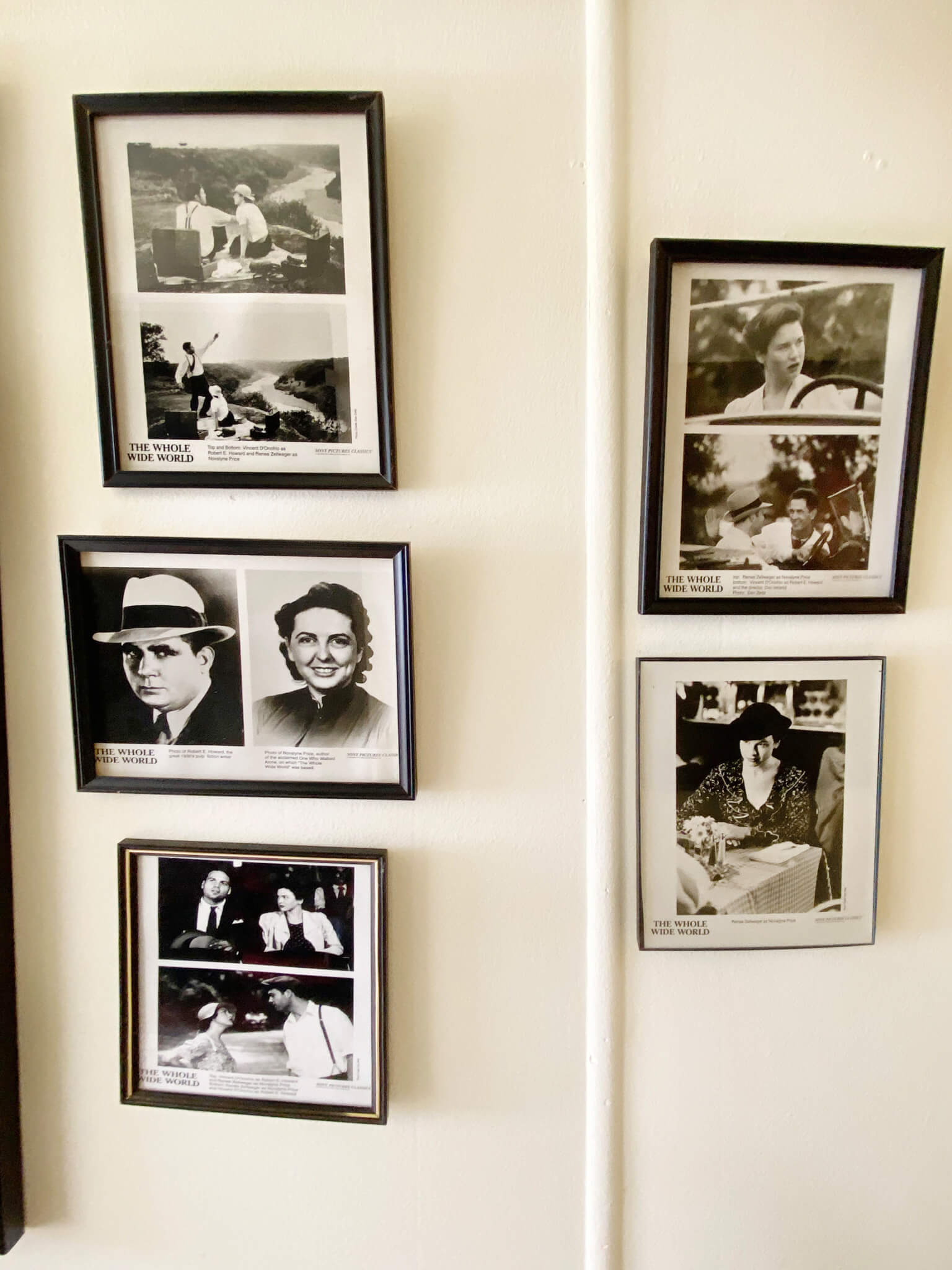
The Cross Plains Public Library
The Cross Plains Public Library is an important but sometimes overlooked star within the constellation of Howard-related landmarks. It’s located on Main Street and is easily identifiable with a beautiful mural painted on its brick exterior. The library is a receptacle for many fascinating Robert E. Howard items, all of which are open for free viewing by the public. I’m so glad I took the time to visit the library, meet the librarian, and see the collection.
The library’s back room is filled with out-of-print rare hardcover and softcover Robert E. Howard books, many of which probably can’t be found outside private collections. I discovered Conan comics, Conan figurines, a movie poster for “Whole Wide World,” pictures of Howard, gorgeous boxed sets, artwork, biographies, and tons of texts related to Howard’s life and mythologies. Paging through the books took me back to when I was a kid and brought home the fact that I had really arrived at the destination of my years-long sojourn.
Howard purists and collectors will admire the vast array of books spanning decades and enjoy seeing rare versions they probably had no idea existed. The librarian chatted with me and was incredibly warm and helpful. She said they had copies of many of Howard’s original typed manuscripts available for review and purchase. She told me stories of the Museum’s impact on Cross Plains and told me the town even hosted a” Barbarian Festival” for a little while.
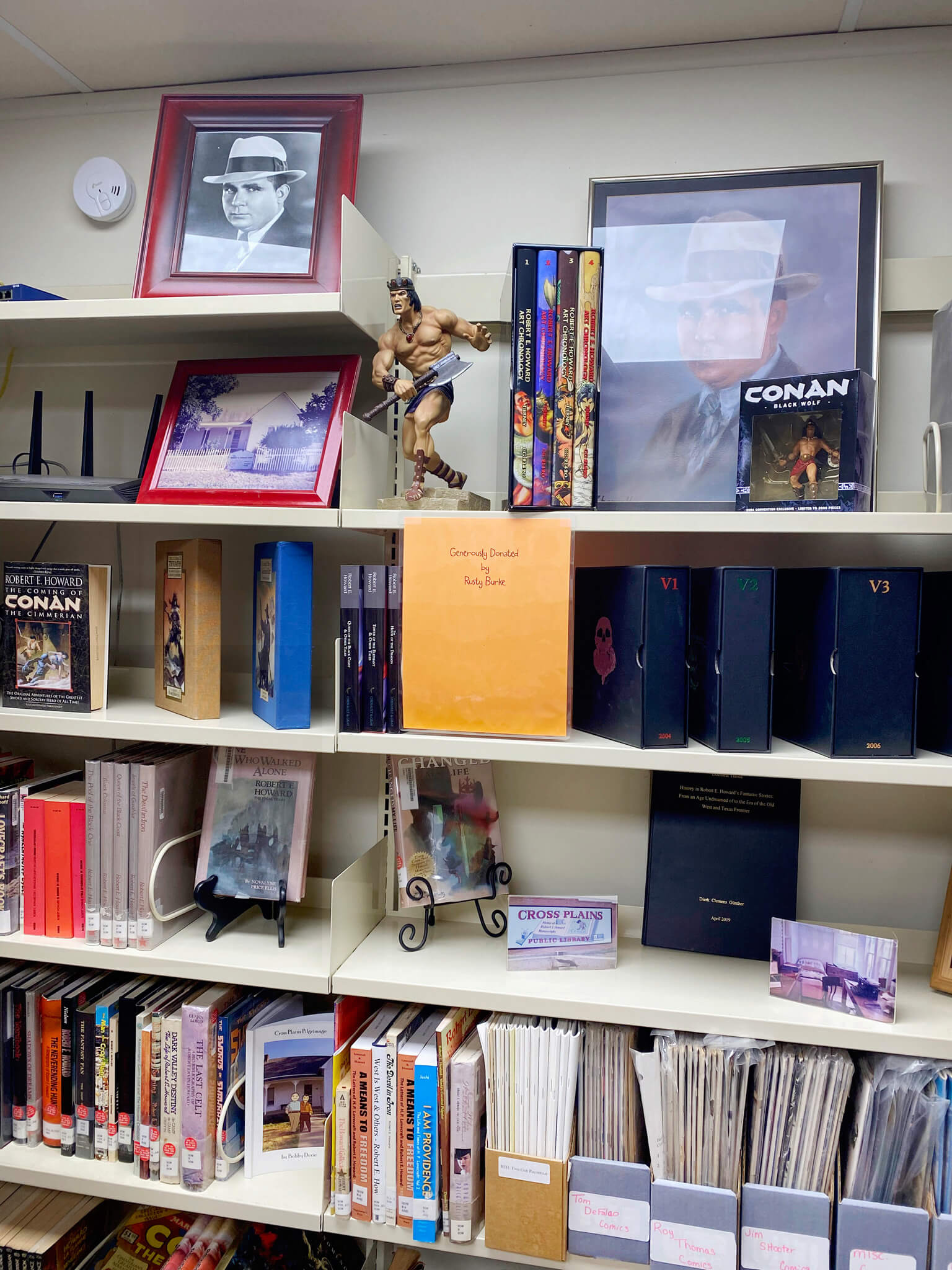
Howard Days in Cross Plains
Howard Days is a two-day fan gathering that takes place annually at the Museum. It’s an extravaganza of Robert E. Howard-related speakers, panels, banquets, auctions, and other special events.
Fans, scholars, artists, writers, historians, and enthusiasts from all over the world meet in this family reunion of sorts. Project Pride helps with the festivities, and the entire City of Cross Plains rolls out the red carpet for Howard Days. The event began in 1986 and continues to grow, providing fellowship and fun for those celebrating the life, works, and legacy of ole’ “Two-Gun Bob.”
Robert E. Howard’s Death
On June 11th, 1936, Robert Ervin Howard walked outside his home and got into his car parked in the driveway. He shot himself in the head with his pistol. He died eight hours later. Robert was 30 years old. His mom, who had suffered from tuberculosis her whole life, had slipped into a coma days earlier. The nurse had just told Robert his mother would never wake.
Much has been said about Robert E. Howard’s suicide, and many writers have conjectured on “why?” Some meditate on a lingering depression that fueled the dark ferocity of his works while at the same time undoing his mental health. Some blame Howard’s deep affection for his mother, reasoning his suicide was the result of an unhealthy attachment and resulting grief from her passing.
But Howard wouldn’t have wanted us to dwell on such matters. I believe he would rather us meet him in his wild places, beside crystalline pools, in ancient ruins, atop mighty peaks, or delving beneath defiled temples. Howard knew redemption and absolution were available to anyone courageous enough to pick up the blade and enter the melee. He believed life was fleeting and that struggle and strife were a better alternative than growing old by the hearth fire in perpetual safety and obscurity.
Robert E. Howard’s Family Gravesite in Brownwood, Texas
Robert E. Howard is buried in Greenleaf Cemetery in Brownwood, Texas, beside his father and mother. His mother passed away the day after Robert died. Their headstone reads poetically, “They were lovely and pleasant in their lives and in their death they were not divided.” The subscript beneath Robert’s name says “Author And Poet.” A Texas Historical Marker plaque sits atop a slender metal pole, briefly summarizing Robert’s life and legacy.
When I arrived in the late afternoon, the headstone was still warm under a fading sun. It was plain, not much larger than any other headstone. Two weathered books and some dead flowers lay at its base. I was the only person there. I sat beside the grave for a while, admiring the changing colors as the shadows lengthened and the last light fell behind the oaks. In the deep quiet, I read passages from a book left there, gently peeling their tattered pages apart. One passage from his Solomon Kane story “Wings In The Night” stood out.
“Over the souls of men spread the condor wings of colossal monsters and all manner of evil things prey upon the heart and soul and body of Man. Yet it may be in some far day the shadows shall fade and the Prince of Darkness be chained forever in his hell. And till then mankind can but stand up stoutly to the monsters in his own heart and without, and with the aid of God he may yet triumph.”
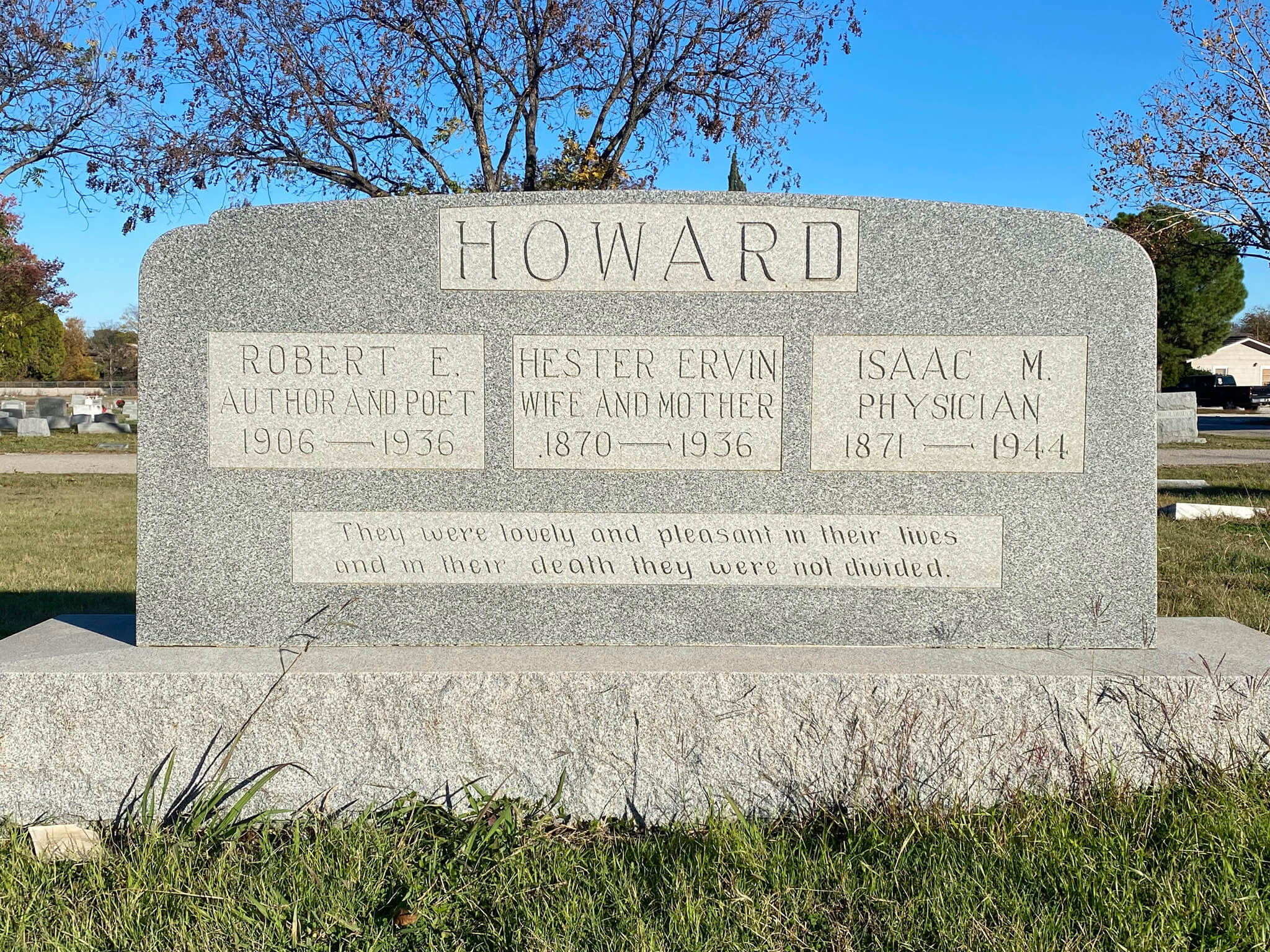
Brownwood, Texas
Brownwood is located about 35 minutes south of Cross Plains. Robert lived in Brownwood from 1922 to 1923 to complete his senior year of high school. At Brownwood High, he met two boys who would become lifelong friends, Tevis Clyde Smith and Truett Vinson. They shared an interest in poetry and writing. It was also at Brownwood High that he won his first writing competitions.
Robert E. Howard’s Legacy
While Howard’s body rests in Greenleaf Cemetery, his legacy has just begun to take flight. His sword arm still sings, and the tall tales born of a kid from central Texas sift through the silvered stars and mantle the imaginations of dreamers, wanderers, and wonderers everywhere. His legends and legacy will spin on, as all good yarns must: loosed to the wind, free and untamed.
Howard’s unmistakable writing style—his coiled crackling kinetic energy, reckless momentum, raw relentless action, and furious panting pace—is his gift to us. In his presence, shackles are sundered, flintlocks are readied, and gloves are cinched. Froth-flecked mouths cut curses against the grim iron-hoofed gods. Silvered cities rise, ancient temples beckon, and honor, fate, and destiny become polestars in the blackest night.
Howard saw the limitless courageous capacity of the soul. He recognized the power of a person with righteous aim and true intentions to overcome daunting odds. He was, in so many ways, the Iron Man boxer, the corsair, the gunslinger, the savage swordsman, and the fallen king. Robert still beckons us with his inner fire, a powerful ethos challenging us to fight our demons, usurp our masters, and cut a path through the dark jungles of self-doubt and fear.
At his best, Howard ignites a fire in us, a thumos born of antiquity, inspiring us to be stronger, better, and more heroic. But he also reminds us those fires burn out, that the lamps expire, sometimes with such rapidity that it leaves us all gasping for breath, saddened and searching again for its flame.
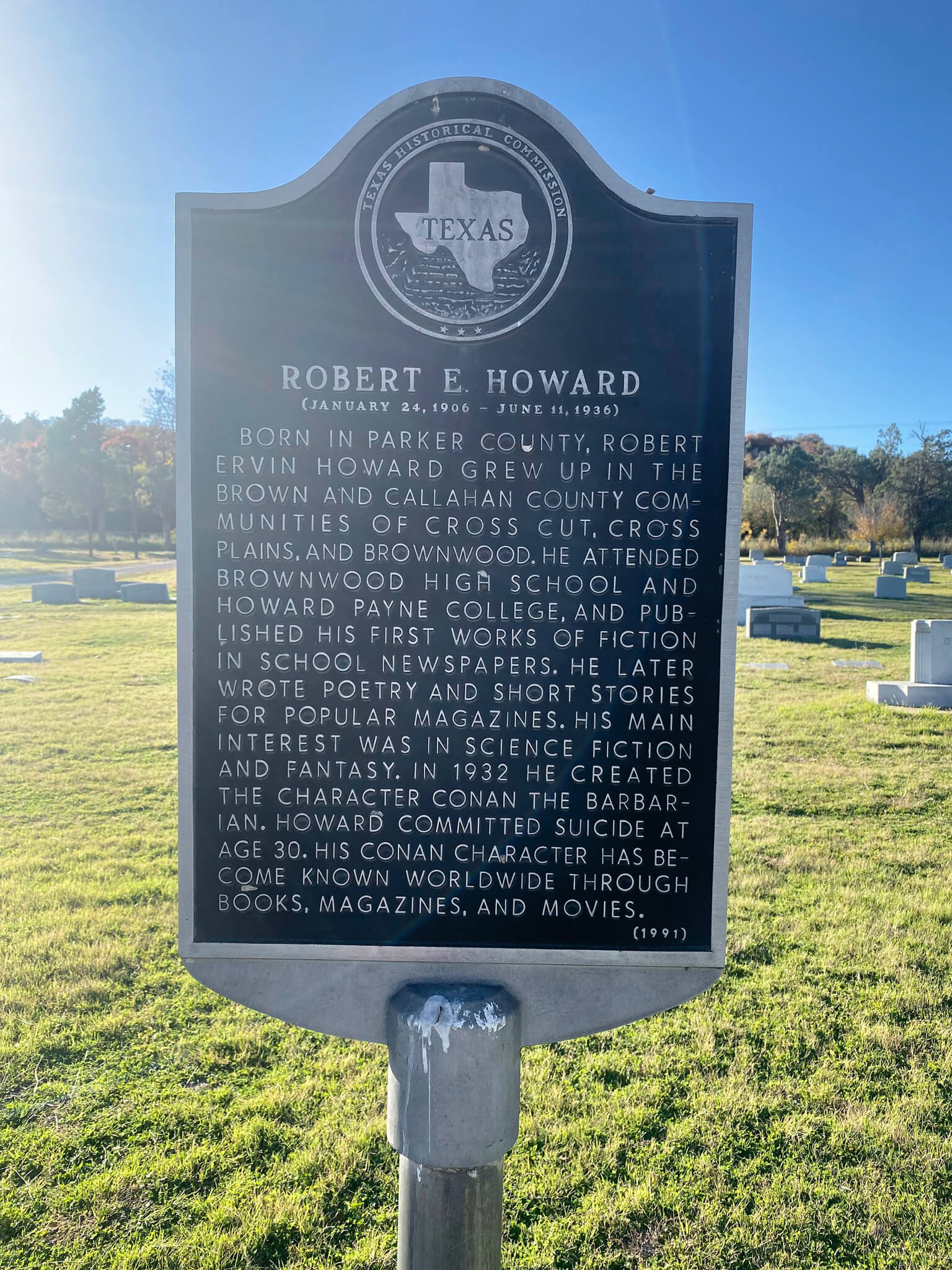
Robert E. Howard Biographies
Several comprehensive biographies of Robert E. Howard have been written. They all give the reader a sense of Howard, who he was, the world he lived in, and offer insight into his mind through his letters, stories, and other communications. If you’re interested in the man, I recommend you check out these works:
The amazing and arguably definitive biography entitled “Blood and Thunder” by Mark Finn.
This excellent online short biography by scholar Rusty Burke.
Conan.com has a really well-done series on Robert E. Howard’s life.
A movie was made about the relationship between Robert E. Howard and Novalyne Price, a school teacher and aspiring writer with whom he became friends. It’s called “The Whole Wide World” and stars Vincent D’Onofrio and Renée Zellweger.
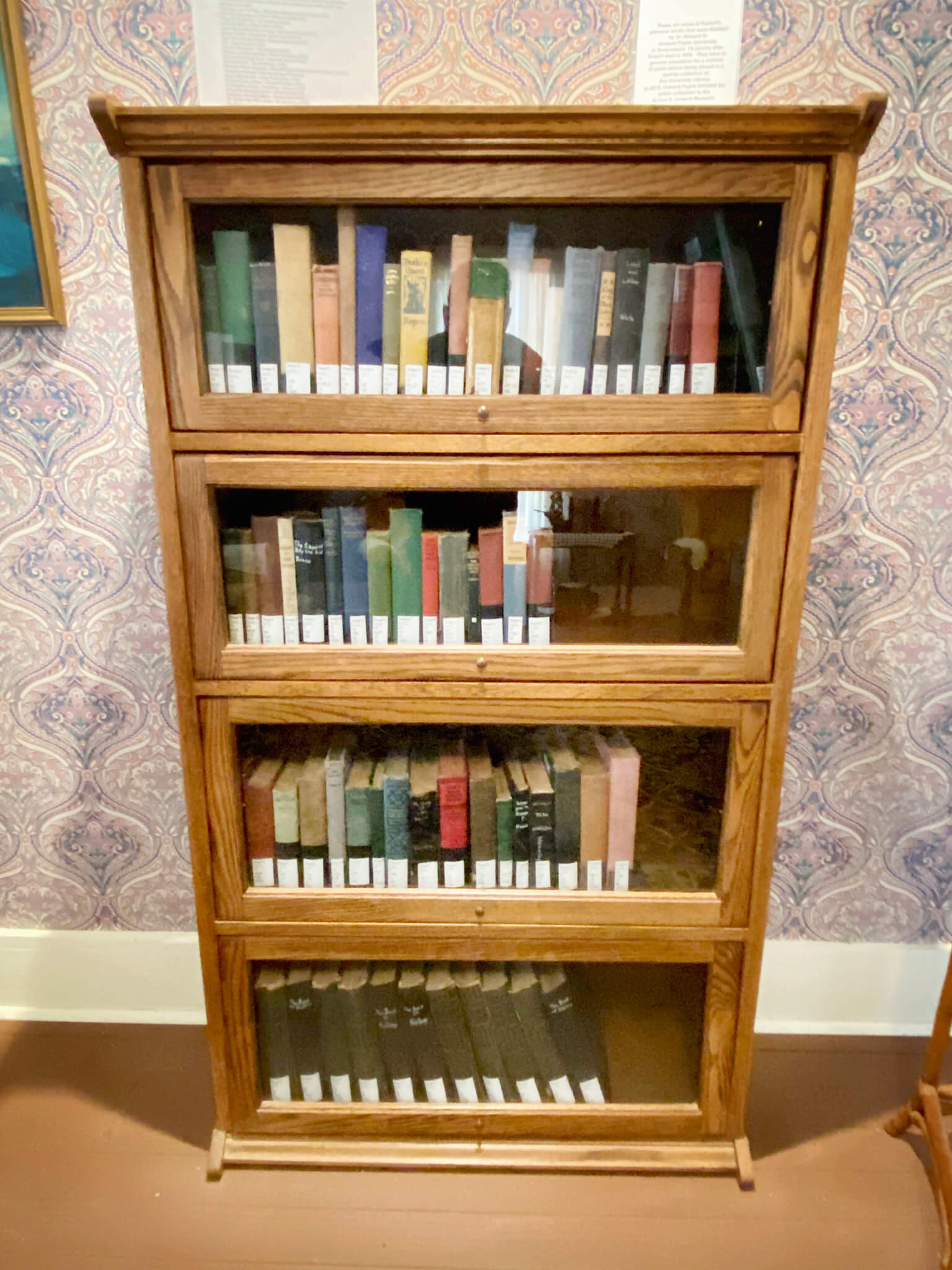
The Characters of Robert E Howard
Here is a summary of some of Robert E. Howard’s fictional characters published in pulp fiction magazines. Howard wrote for the pulps from 1924 until his death in 1936. His first published story was “Spear and Fang,” for the pulp magazine Weird Tales. A short list of pulps that published Howard’s works includes Action Stories, Argosy, The Magazine of Fight Stories, Magic Carpet Magazine, Oriental Stories, Spicy-Adventure Stories, Sport Story Magazine, Strange Detective Mysteries, and Weird Tales.
Conan
Conan is a legendary warrior and adventurer hailing from the mythical land of Cimmeria. Known for his brute strength, cunning intellect, and indomitable spirit, Conan roams the Hyborian Age, facing formidable foes, uncovering ancient mysteries, and carving out his destiny as a king.
Solomon Kane
Solomon Kane is a grim Puritan swordsman who wanders Europe and Africa’s dark and treacherous paths. Armed with a rapier and flintlock pistols, Kane battles against supernatural forces and human evil, guided by his unwavering faith and sense of duty.
Kull of Atlantis
Kull, the enigmatic warrior-king of Atlantis. With his keen intellect and unmatched combat prowess, Kull navigates the treacherous politics of his kingdom and faces otherworldly threats in his quest to safeguard his people and his throne.
Bran Mak Morn
Bran Mak Morn is the last king of the Picts, a fierce and ancient tribe of warriors in ancient Britain. Morn wages a desperate struggle against invading forces.
El Borak
Francis Xavier Gordon, known as El Borak, is a dashing American adventurer embroiled in daring escapades across the deserts of the Middle East and Central Asia.
Red Sonya of Rogatino
Red Sonya is a fiery and skilled swordswoman from the land of Hyrkania, renowned for her prowess in battle and unwavering sense of honor.
Dark Agnes de Chastillon
Dark Agnes is a fierce and independent swordswoman from 16th century France, skilled in combat and unafraid to challenge societal norms.
The Sonora Kid
The Sonora Kid is a charismatic outlaw and gunslinger who roams the lawless frontier of the American Southwest, leaving a trail of chaos in his wake.
Cormac Fitzgeoffrey
Cormac Fitzgeoffrey is a roguish Irish outlaw turned mercenary who navigates the tumultuous politics of medieval Ireland with cunning and bravado.
Steve Harrison
Steve Harrison is a hard-boiled private detective operating in the mean streets of Chinatown.
Turlogh Dubh O’Brien
Turlogh Dubh O’Brien is a fierce Gaelic warrior and outlaw who wanders the war-torn landscapes of medieval Ireland in search of revenge and redemption.
Sailor Steve Costigan
Sailor Steve Costigan is a rough-and-tumble merchant marine known for his brawling skills and larger-than-life personality.
Breckinridge Elkins
Breckinridge Elkins is a lovable yet dim-witted mountain man from the Nevada hills whose misadventures often land him in absurd and hilarious situations. Elkins appeared in the pulps and was a character in Howard’s only published novel, “A Gent From Bear Creek.”
Cormac Mac Art
Cormac Mac Art is a legendary Irish warrior and adventurer whose exploits take him from Ireland’s misty shores to the Mediterranean’s sun-drenched deserts.
Kirby O’Donnell
Kirby O’Donnell is a dashing American treasure hunter who plies his trade in the chaos of revolutionary Afghanistan in the early 20th century.
Dennis Dorgan
Dennis Dorgan is a hard-fighting sailor and pugilist who brawls his way across the high seas and into the Orient.
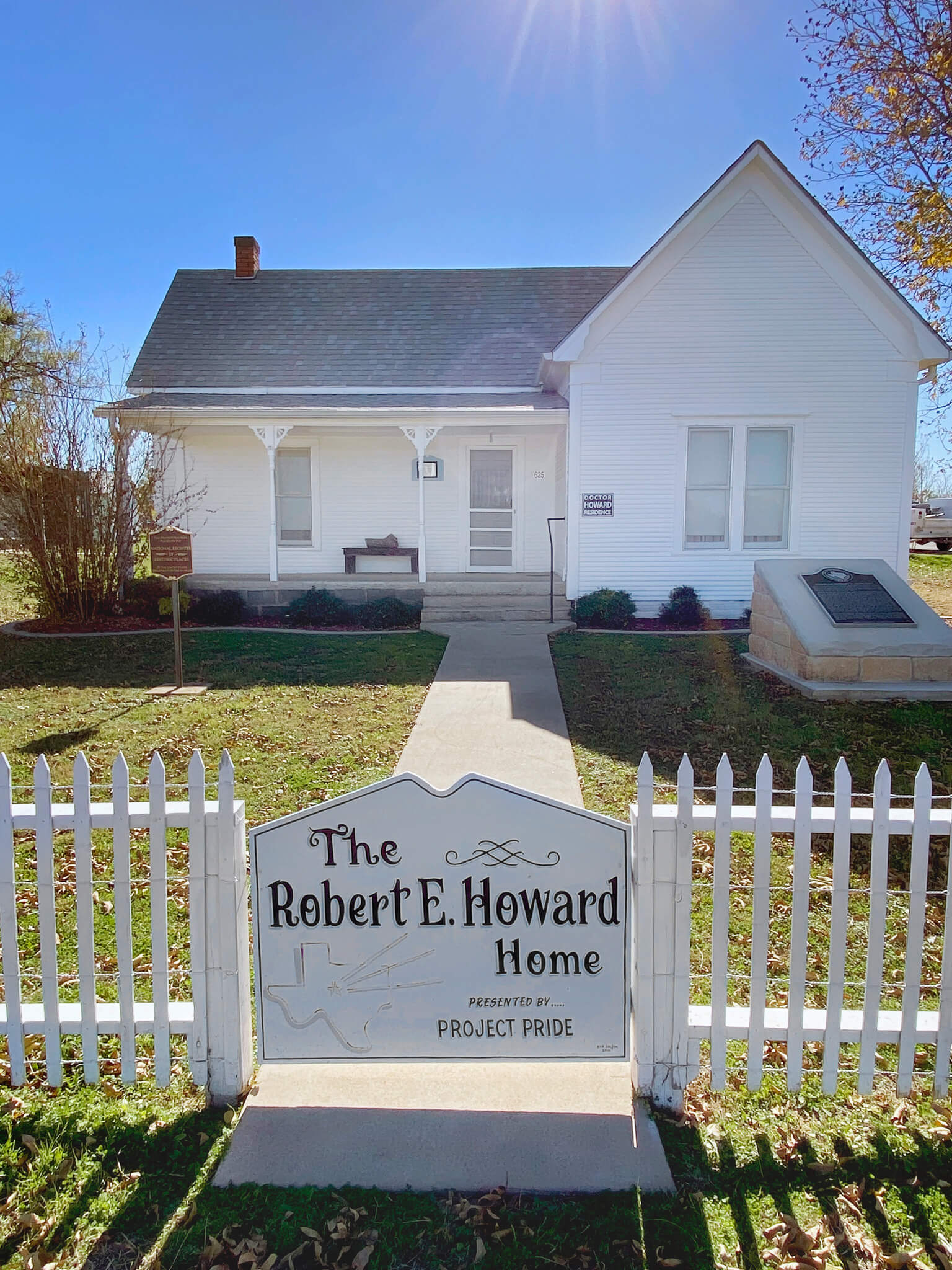
Robert E. Howard Museum Address
Museum Information: https://reh.world/articles/museum/
Museum Address: 625 SW Fifth St, Cross Plains, TX 76443, United States
The Museum is open by appointment only.
Additional REH Resources
Pin This Robert E. Howard Blog Post
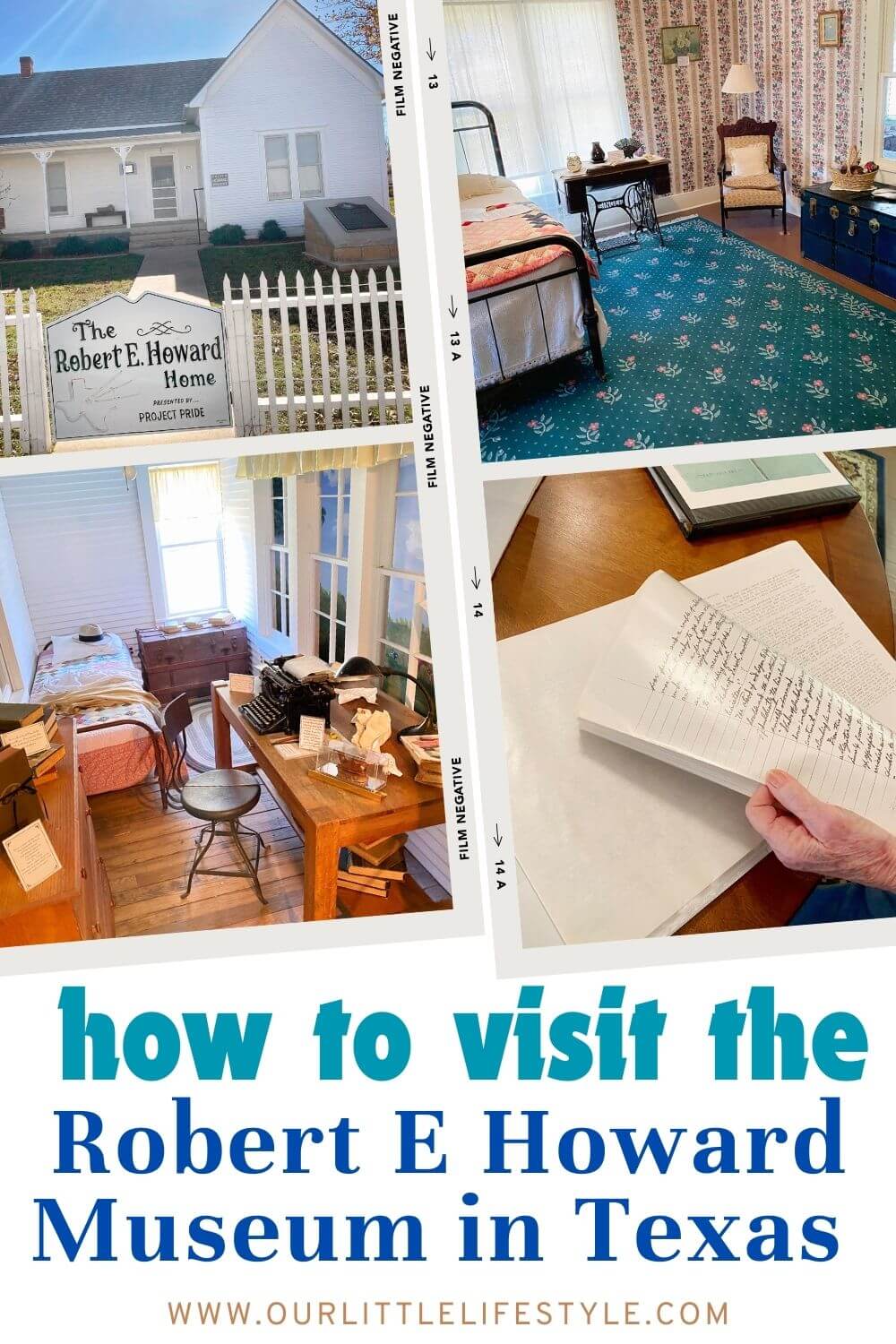
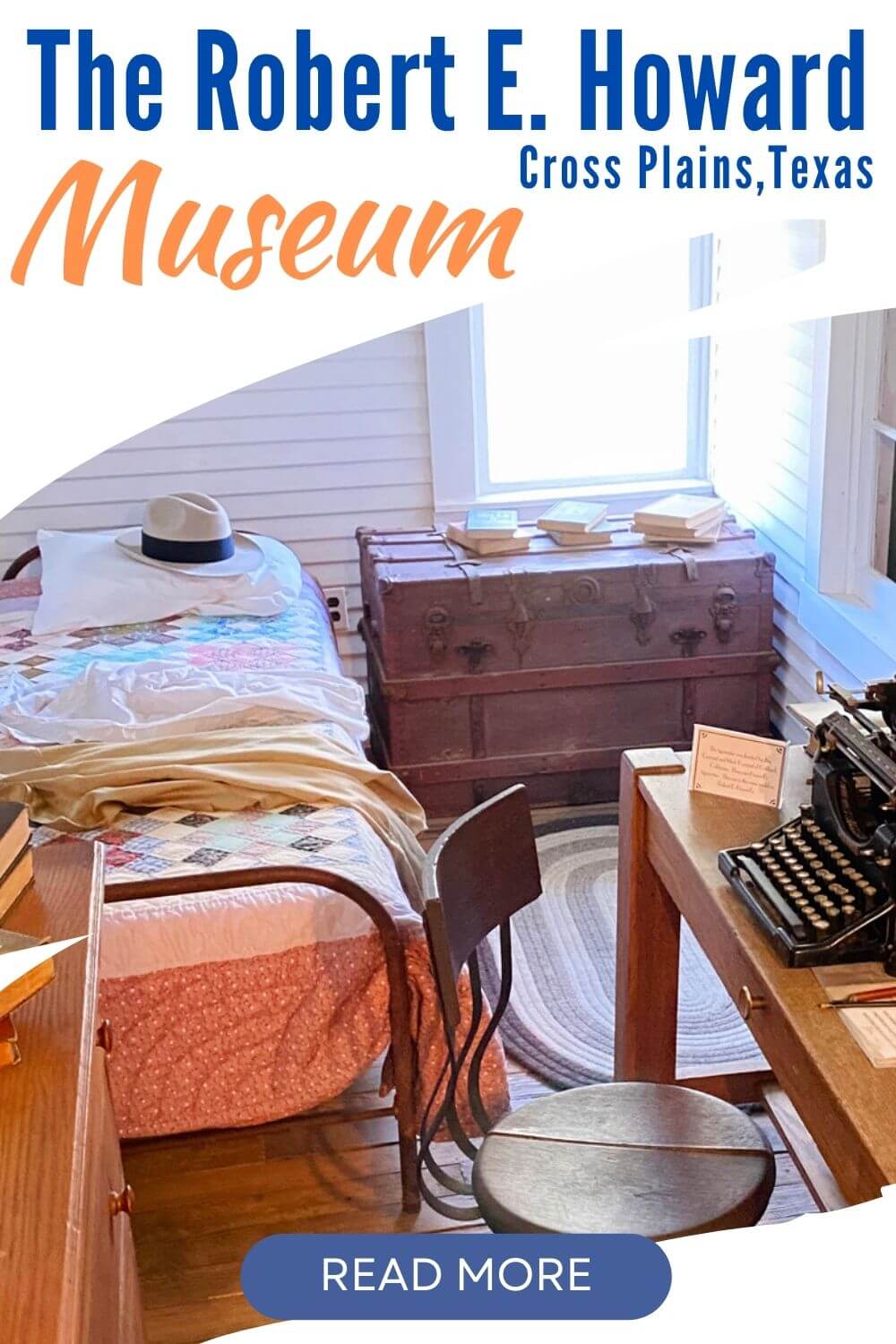
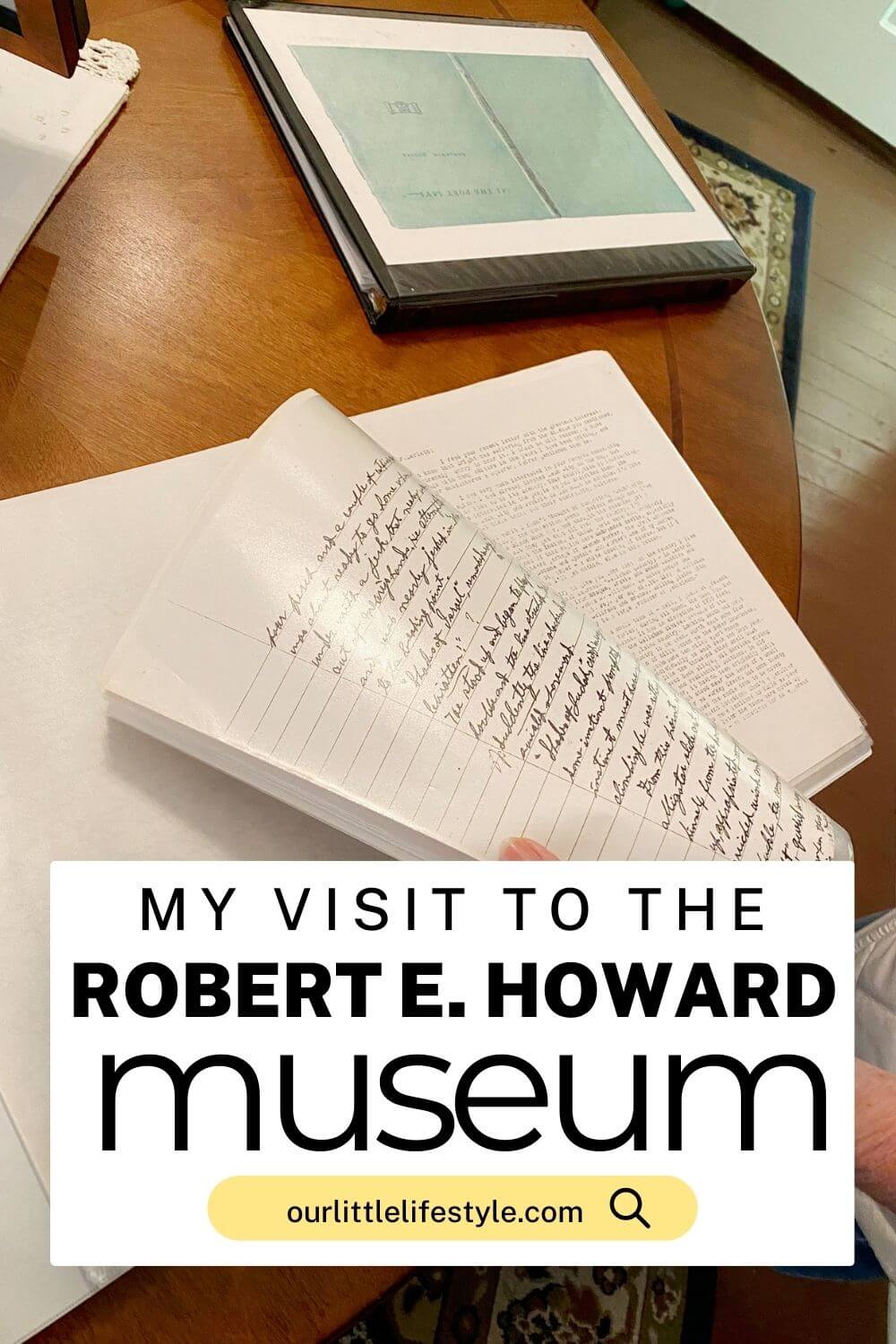


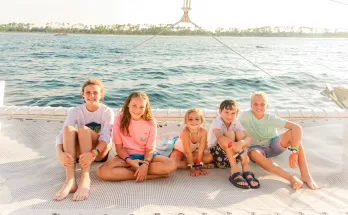
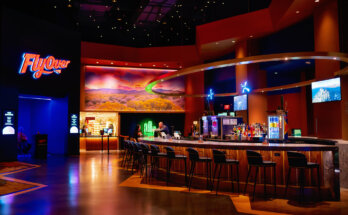
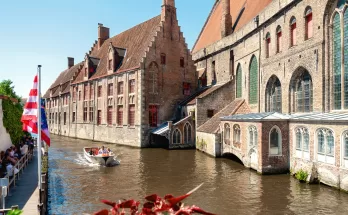
Lovely write up , I hope you are able to visit Howard Days at some point as it’s a great experience.